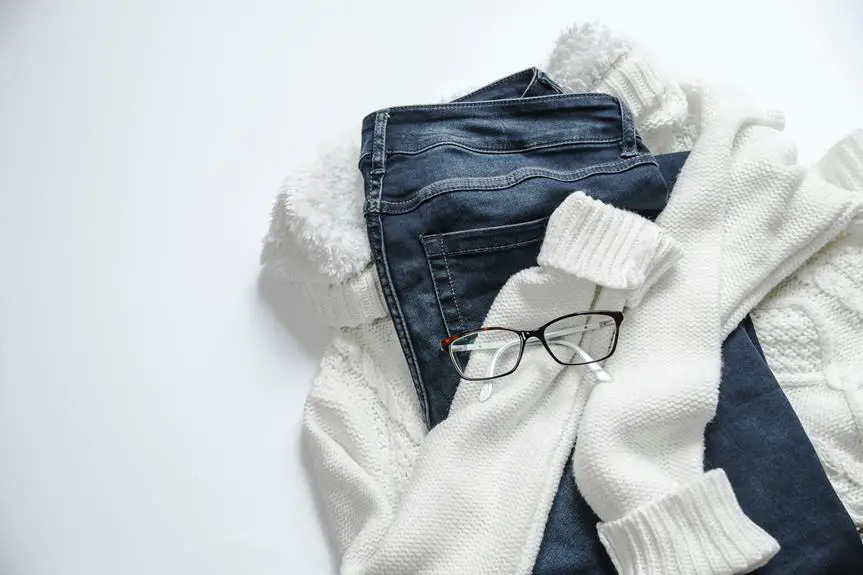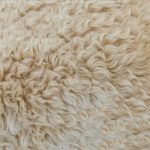When you're choosing Madras plaid for a garment, you might not realize how much it influences drape. The lightweight fabric and vibrant patterns can shape not just the look but also the feel of the piece you create. Depending on the weight and fiber composition, you'll find that some plaid styles flow effortlessly, while others hold a more structured form. This interplay between fabric and pattern plays a crucial role in comfort and versatility. Curious about how these elements come together and affect styling options? Let's explore that further.
Table of Contents
Characteristics of Madras Plaid
Madras plaid is known for its vibrant colors and distinctive patterns, making it a favorite choice for casual and summer attire. You'll immediately recognize it by its checked designs, often featuring a mix of bright hues like red, green, yellow, and blue. This eye-catching style not only boosts your wardrobe but also brings a sense of fun and individuality to your outfits.
Traditionally, these patterns originated from India, which gives madras plaid a rich historical context. You might find yourself drawn to its lightweight fabric, often cotton or linen, perfect for hot weather. The texture feels breathable against your skin, allowing for comfort during those warm, sunny days.
When you choose madras plaid, you're also embracing versatility. It pairs well with various styles; you can wear it as shorts, shirts, or dresses. Its casual vibe means you can easily dress it up or down, whether you're heading to a beach party or a backyard barbecue.
Fabric Weight and Drape
Understanding fabric weight is key to how your Madras plaid drapes.
Heavier materials often create a more structured silhouette, while lighter fabrics flow effortlessly.
Take note of how the plaid pattern interacts with the fabric density, as this can influence the overall look and feel of your garment.
Impact of Fabric Density
Fabric density plays a crucial role in how garments drape, influencing everything from comfort to the overall aesthetic of the final piece. When you choose a fabric, its weight directly affects how it falls and flows.
Lighter fabrics, with lower density, typically create a softer drape, allowing for more movement and a relaxed silhouette. This can lead to a breezy, easygoing feel that's perfect for casual wear or warm climates.
On the other hand, heavier fabrics exhibit a firmer drape, offering structure and support to your garment. These dense materials, like canvas or denim, maintain their shape well, making them ideal for tailored pieces or outerwear. The weight also contributes to how the fabric interacts with your body; a heavier garment might feel more supportive, whereas a lightweight one could feel almost weightless.
Moreover, the drape you achieve affects how you perceive your garments on the body. Whether you're going for a flowy maxi dress or a structured blazer, understanding fabric density is essential for creating the desired silhouette and ensuring comfort while wearing it.
Your choices in density will significantly shape the final look and feel of your pieces.
Influence of Plaid Pattern
Plaid patterns, influenced by the weight and density of the fabric, significantly impact how a garment drapes and falls on the body.
When you choose a lighter plaid fabric, like cotton, you'll find it flows more easily, creating a relaxed look that's perfect for casual styles. This lightweight material tends to cling less, allowing for a more flattering silhouette, especially in tops and dresses.
Conversely, heavier plaids—such as wool or thicker blends—will add structure and form to your garment. When you wear these fabrics, you'll notice they maintain their shape while providing a more tailored appearance. This is ideal for fitted jackets or trousers. The density of the fabric can affect how it moves with you; heavier options may restrict movement slightly, while lighter fabrics allow for greater freedom.
Ultimately, the choice of plaid pattern and fabric weight is essential to achieving the desired aesthetic and functionality in your outfit. So, whether you're aiming for a laid-back vibe or a polished look, consider how the density of the fabric and the type of plaid will complement your style and body shape.
It all plays a role in how you present yourself.
Influence of Fiber Composition
The choice of fiber composition plays a crucial role in determining the overall drape and appearance of Madras plaid garments. When you select fabrics, consider how each fiber impacts the way the garment hangs on the body.
For example, cotton fibers offer a soft, breathable feel, which allows for a relaxed drape that's perfect for warm weather. This characteristic often leads to a casual, easygoing look in Madras plaid.
On the other hand, synthetic fibers like polyester can create a different vibe. They often provide a stiffer drape that helps maintain structured silhouettes, making the plaid patterns look sharp and defined. This can be particularly beneficial if you're aiming for a more polished appearance or a tailored fit.
Blends also present unique possibilities. By combining natural and synthetic fibers, you can achieve a balance between softness and durability, influencing the garment's overall flow.
Ultimately, your choice of fiber affects not only the drape but also comfort and versatility. Think about how you want your Madras plaid to function, and choose fibers that align with your vision. This careful selection can make all the difference in the finished piece.
Pattern Impact on Flow
Different patterns can significantly affect how a Madras garment flows, influencing both its movement and drape on your body. The visual complexity of the plaid can determine how the fabric interacts with your shape. Larger, bolder patterns might create a more structured appearance, while smaller, intricate designs allow the fabric to cascade elegantly.
Here's a quick breakdown of how various Madras patterns impact flow:
| Pattern Type | Flow Impact |
|---|---|
| Bold Checks | Adds structure; may restrict movement. |
| Fine Plaid | Enhances fluidity; drapes softly. |
| Vertical Stripes | Creates an elongated effect; improves movement. |
| Horizontal Stripes | Can add width; may hinder flow. |
| Small Patterns | Offers versatility; adapts to body movements. |
Choosing the right pattern can elevate your overall look, giving you confidence and comfort. As you explore different designs, think about how each one affects not just appearance, but also how you feel in the garment. This consideration ensures your Madras plaid drapes beautifully, enhancing the flow of your style.
Garment Construction Techniques
Understanding how various construction techniques influence a garment's drape and overall fit is vital when working with Madras plaid fabrics. When you're sewing with this lightweight cotton, you'll want to consider techniques that enhance its natural flow. For instance, using bias-cut patterns can create soft, elegant drape, allowing the plaid to move beautifully on the body.
Incorporating lightweight interfacing will also help maintain structure without adding bulk, keeping the garment looking sharp. Ensure that your seams are properly finished—consider using French seams for a clean look that reduces fraying, which can affect the fabric's drape over time.
Additionally, the choice of hems matters; a rolled hem can provide a delicate finish, enhancing the plaid's visual appeal without interfering with its natural movement. Pay attention to the construction order, too. For instance, assembling panels in a way that aligns the plaid can ensure a more cohesive drape.
Styling Tips for Madras Plaid
When styling Madras plaid, you'll want to consider color combinations that enhance your look while keeping patterns in mind.
Think about the weight of the fabric too, as it can affect how the garment drapes on your body.
Plus, seasonal styling ideas can help you make the most of this classic print throughout the year.
Color Combinations and Patterns
Madras plaid offers vibrant color combinations that can elevate any outfit, making it easy for you to create stylish looks. If you're unsure where to start, consider pairing a bright madras shirt with neutral bottoms like khaki shorts or white jeans. This balance allows the colors in your plaid to pop without overwhelming your ensemble.
For a bolder approach, try mixing different madras patterns, but keep the colors somewhat similar to maintain harmony. For example, a red and blue madras can pair well with green and yellow accents, creating an eye-catching, layered effect. Just remember to keep one piece as a focal point to avoid visual chaos.
Accessorizing is key too! A simple madras scarf or hat can bring in a burst of color while complementing your outfit. If you prefer a more understated style, opt for madras in calmer tones, like pastels, and pair them with softer, solid colors.
Lastly, consider seasonality. Lighter shades work well in spring and summer, while deeper hues can transition well into fall. With these tips, you'll confidently rock your madras plaid while showcasing your unique style.
Fabric Weight Considerations
Choosing the right fabric weight for your madras plaid can make all the difference in how you style your outfit. Lighter fabrics like cotton or linen drape effortlessly and work well for casual, laid-back looks. These materials are perfect for summer days, allowing you to stay cool while still looking stylish. Pair a lightweight madras plaid shirt with shorts or flowy skirts to keep it breezy.
On the other hand, if you opt for a heavier fabric, like a wool blend, you can create a more structured feel. This works great for layering and can be styled in a more formal context. Think about wearing a madras plaid blazer over a solid dress for an effortlessly chic look.
When choosing fabric weight, also consider the occasion and season. Heavier weights provide warmth, making them ideal for fall and winter ensembles, while lighter options maintain breathability during hot weather.
Whichever weight you choose, remember that the drape of your madras plaid will influence how you feel in your outfit. Experiment with different weights to find the balance that suits your style and comfort level best.
Seasonal Styling Ideas
To make the most of your madras plaid, consider incorporating seasonal elements that enhance its vibrant patterns and colors. For spring and summer, look for lightweight, breathable fabrics that keep you cool while showing off the plaid's brightness. Pair your madras plaid shirt with white denim shorts or a flowing maxi skirt for a fresh, casual look.
As seasons transition, you can layer with additional elements. For autumn, wear a madras plaid scarf over a fitted turtleneck and tailored trousers. In winter, don a classic madras plaid coat paired with cozy knits and your favorite boots.
Here's a quick reference table to help you style madras plaid across different seasons:
| Season | Styling Tip |
|---|---|
| Spring | Pair with white shorts or a light maxi skirt. |
| Summer | Combine with sandals and a denim jacket. |
| Autumn | Layer with a turtleneck and tailored trousers. |
| Winter | Wear a madras plaid coat over cozy sweaters. |
With these tips, you'll easily adapt your madras plaid wardrobe for any season!
Frequently Asked Questions
What Is the History Behind Madras Plaid Fabric?
Madras plaid originated in India during the 17th century, created by skilled weavers. It became famous for its vibrant colors and patterns, eventually finding popularity in Western fashion, particularly in casual wear and summer attire.
Is Madras Plaid Suitable for Formal Occasions?
Madras plaid can be suitable for semi-formal occasions, pairing well with tailored pieces. Just make sure to choose high-quality fabric and complementary colors, and you'll look effortlessly stylish without sacrificing comfort or personality.
How Do I Care for Madras Plaid Garments?
To care for your madras plaid garments, wash them in cold water, avoid bleach, and tumble dry on low. Iron on a low setting to keep the colors vibrant and the fabric looking fresh.
Can I Mix Madras Plaid With Other Patterns?
Absolutely, you can mix madras plaid with other patterns! Just ensure the colors complement each other and maintain a balanced look. Experiment with different scales, and don't be afraid to show off your unique style!
What Cultural Significance Does Madras Plaid Hold?
Madras plaid represents a rich cultural heritage, originating from India. You'll find it symbolizing warmth, hospitality, and craftsmanship, while reflecting a fusion of traditional and modern influences that resonate across various fashion contexts today.
- How Does Ring Spun Cotton Affect Garment Fit and Shape Retention? - August 13, 2024
- What Are the Challenges in Producing Ring Spun Cotton? - August 13, 2024
- Is Ring Spun Cotton Suitable for Plus-Size Clothing? - August 13, 2024







